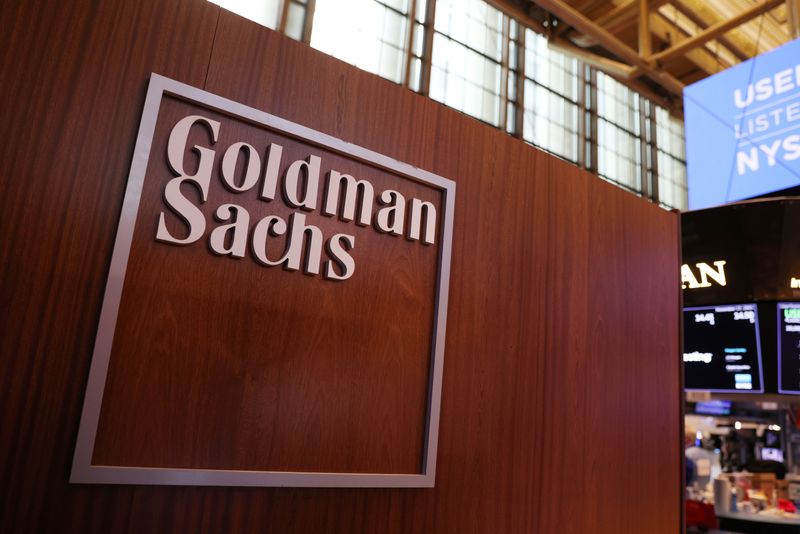
© Reuters. FILE PHOTO: The logo for Goldman Sachs is seen on the trading floor at the New York Stock Exchange (NYSE) in New York City, New York, U.S., November 17, 2021. REUTERS/Andrew Kelly
By Saeed Azhar and Niket Nishant
NEW YORK (Reuters) -Goldman Sachs’ profit dropped 60% in the second quarter, missing estimates, as writedowns on the investment bank’s consumer businesses and real estate investments weighed on earnings.
But shares rose almost 2% as CEO David Solomon cited signs of a recovery in investment banking. The results were the worst for the Wall Street giant since the second quarter of 2020, when it took writedowns over a corruption scandal linked to Malaysian state fund 1MDB.
The economic environment “definitely feels better over the course of the last six to eight weeks,” Solomon told analysts on a conference call. “The inflation data’s been better, the client sentiment is better, and now we’ll have to watch and see.”
He cited activity picking up in equity capital markets and a revival of client discussions on mergers and acquisitions.
Goldman took $1.4 billion in writedowns in the second quarter tied to its GreenSky fintech business, which facilitates home improvement loans to consumers and real estate investments. It also booked credit losses related to its consumer loans and credit card business.
“This moment in the economic cycle creates meaningful headwinds for Goldman Sachs (NYSE:),” Solomon said. “We are making tough decisions that are driving the strategic evolution of the firm. Given both these factors, it should come as no surprise that we’re going to a period of lower results.”
Earnings fell 60% to $3.08 per share for the three months ended June 30, compared with $7.73 per share a year earlier, the bank reported on Wednesday. Analysts had expected a profit of $3.18 per share, according to Refinitiv data.
“The bar was relatively low heading into the quarter,” wrote Citigroup (NYSE:) analyst Keith Horowitz. “When we compare the results against our estimates, we find that core trends were generally positive,” helped by equities financing and investment banking.
Net earnings dropped 62% to $1.07 billion in the second quarter versus $2.79 billion a year earlier.
Goldman agreed to acquire GreenSky for $2.2 billion in 2021 and later closed the deal at $1.7 billion.
Goldman’s Marcus unit was also folded into its merged asset and wealth management arm last year, as the investment bank began pulling back from retail banking.
The sale of “substantially all of the remaining” Marcus loans portfolio also resulted in a gain of $100 million for Goldman.
“The goodwill impairment related to GreenSky, although small, highlights the firm’s difficulties in executing its diversification strategy at exactly the moment that its core businesses face headwinds,” said Mark Narron, a senior director at Fitch Ratings.
Revenue from Goldman’s asset and wealth management operations fell 4% compared with last year, hurt by losses from real estate investments, although the unit recorded record fees and assets under supervision.
The bank plans to sell some of its commercial real estate-related investments in three to five years.
The results contrast with major Wall Street rivals whose earnings beat expectations, including JPMorgan Chase (NYSE:) and Morgan Stanley (NYSE:) . Executives cited a resilient economy, but cautioned that high borrowing costs will begin to weigh on loan demand later this year.
Goldman’s investment banking fees for the quarter fell 20% to $1.43 billion. Trading revenue for fixed income, currency and commodities fell 26%, while equities rose 1%.
The Federal Reserve’s aggressive interest-rate increases to tame inflation have prompted executives to predict a slowdown in the second half of the year.
The uncertain outlook has weighed on mergers and acquisitions, while a flurry of initial public offerings have stoked some optimism about a nascent recovery.
On Tuesday, Goldman’s peer Morgan Stanley said its investment banking revenue was in line with last year, but the trading business had weakened.
Analysts are optimistic that an ongoing recovery in stock markets will encourage dealmaking and prompt more IPO hopefuls to list their shares in the coming months.
However, uncertainty about the trajectory of the economy continues to be a hurdle with global mergers and acquisitions activity falling 36% from last year in the second quarter.
Goldman Sachs has laid off thousands of employees to curb costs and soften the hit from a dealmaking slump. More employees can expect to be laid off this year if revenue does not bounce back, a source previously told Reuters.
The bank’s headcount fell 2% from the first quarter to 44,600.








